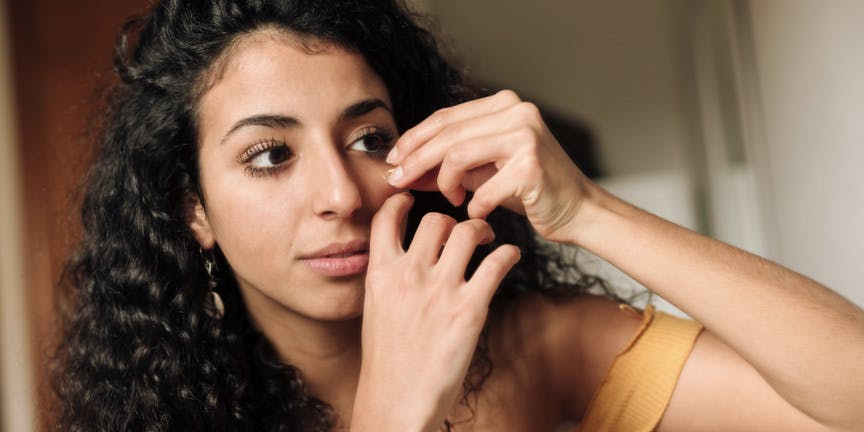
Where can I buy Latisse?

Topics
Key Points
- Lack of eyelashes is a medical condition called hypotrichosis. Hypotrichosis can happen anywhere on the body and be caused by many different factors like age, genetics or medication use.
- Latisse (and its generic form, Bimatoprost) is the only proven prescription eyelash treatment that encourages longer, thicker and darker eyelashes.
- Some lifestyle changes—like diet and how you apply or remove makeup—can also help protect eyelashes.
Most people have between 90-160 eyelashes on the upper lid and 75-80 lashes on the lower lid. And of all body hair, eyelashes are the thickest and most pigmented. Eyelashes play an important role in eye health. But what can you do if your eyelashes are thin, sparse or missing?
Below, here’s what to know about how prescription eyelash medications can help grow thicker, fuller and darker lashes. Plus, how Dr. B can help you get same-day eyelash treatment from licensed medical providers.
What causes a lack of eyelashes?
Eyelashes help protect our eyes by blocking irritants like dust, wind and even sunshine. Like the whiskers on a cat, they are very sensitive to touch. When stimulated, they rapidly trigger the eye to close. This helps protect the eye from trauma.
They also help keep the eyelids healthy. If you don’t have enough eyelashes, it can lead to inflammation and irritation as well as more serious conditions like eye infections and dry eye disease.
The medical term for not having enough hair is hypotrichosis. It can happen anywhere on the body—including your eyelashes. This diagnosis is used when eyelashes are too short, too thin or if they don’t grow at all.
Some people don’t have enough eyelashes due to genetics. Others lose their lashes after taking certain medications, like chemotherapy. Age, hormonal changes, chronic stress and eye irritation can also affect eyelash growth.
What is Latisse?
Latisse (and the generic version, Bimatoprost) is the only prescription eyelash treatment that effectively encourages eyelash growth. It’s a type of medicine known as a prostaglandin analog.
Prostaglandin analogs like Bimatoprost cause hair follicles to move from a resting phase to an active growth phase. This results in greater lash growth. It also extends the growing phase, so lashes grow longer.
When used as directed, fuller, thicker lashes will be apparent after several weeks—but it can take up to 16 weeks to see full results. And it only works for as long as you use it. Once you stop, your eyelashes will return to their usual thickness and quantity.
Is Latisse safe?
The medicine in Latisse and Bimatoprost is the same medicine that’s used to treat glaucoma, an eye condition. When used to treat glaucoma, it’s placed directly in the eye as an eye drop. So you don’t need to worry if a little bit drips into your eye when using this medicine. That said, if it gets into your eye repeatedly, it could change the color of the iris (the colored portion of your eye).
The side effects of these medicines are usually mild. Since Latisse is applied to the base of the eyelashes (instead of into the eye itself), it causes fewer side effects than medicines that are taken by mouth.
Tell your doctor about any side effects, including:
- Itchy eyes
- Dry eyes
- Eye irritation or redness
- Changes in skin color where applied
- Changes in eye color
- Eye pain
It’s important to talk to a healthcare provider before starting any new medication. They can make sure that all your prescriptions are safe for your specific circumstance.
How to use Latisse
Prescription eyelash treatments are simple to use. They’re applied daily to the skin of the upper eyelid margin, just like eyeliner. You don’t need to put it on the lower lash—the medicine will spread there naturally when you blink.
To use prescription eyelash medicine correctly:
- Wash your hands before and after using the medicine
- Take out a new, clean applicator
- Apply a thin layer of medicine to the upper eyelid margin, right along the lash line
- Discard the applicator and use a new one on your other eye
This medicine can cause hair growth outside of the eyelashes. So only use it as directed on the upper eyelid. If the medicine drips or splashes on your skin, just rinse it off.
How to encourage eyelash growth at home
Prescription eyelash treatments will only work if you keep your eyes healthy.
A nutritious diet full of healthy fats, leafy greens and lean protein can help your hair grow.
You can also try over-the-counter (OTC) eyelash serums to moisturize and protect eyelashes. Just be aware that cosmetics aren’t regulated the same way as medicines, and there’s limited evidence that pricey OTC serums work.
It’s also a good idea to check your medications to make sure drugs or drug interactions aren’t causing your lash issues. Talk to your provider before stopping any medications, though.
Here are some other ways to protect your eyelashes:
- Avoid picking or pulling on your eyelashes
- Avoid makeup that dries your lashes or makes them weak or brittle
- Don’t scrub or rub your eyes when removing makeup—gently pat with a clean cotton ball and a mild makeup remover
- Don’t share makeup with others
- Throw out old or expired makeup
- Wash your hands before applying eye makeup
- Avoid strong eyelash glue or other cosmetics that could damage the lashes
- Be careful with tools like eyelash curlers—don’t use them too roughly
How to get an online Latisse prescription
If you have sparse or thin eyelashes—or no eyelashes at all—it’s important to understand what’s causing your eyelash issues. If you’re not sure what’s causing your eyelash problems, talk to your provider. They can help rule out issues that impact eyelash growth like trauma, medications or disease.
When you’re ready to start growing longer, fuller lashes, treatments like Latisse and Bimatoprost may help. And with Dr. B, you can get that prescription eyelash growth medication without leaving home!
First, start a $15 online consultation. A licensed medical provider will review your health history and current symptoms within three working hours. If a prescription is appropriate, they’ll send it to the pharmacy of your choice. We’ll even help you secure the lowest cost for the medication at your local pharmacies.
So get going—and get growing!
Sources
Aumond, S., et al. (2018). The eyelash follicle features and anomalies: A review. Journal of Optometry.
Glaser, D. A., et. al. (2015). Long-term safety and efficacy of bimatoprost solution 0·03% application to the eyelid margin for the treatment of idiopathic and chemotherapy-induced eyelash hypotrichosis: a randomized controlled trial. The British Journal of Dermatology.
Huang A., et al. (2022). Bimatoprost ophthalmic solution. StatPearls Publishing.
Law S. K. (2010). Bimatoprost in the treatment of eyelash hypotrichosis. Clinical Ophthalmology.
MedlinePlus. (2016). Bimatoprost Topical.
Topics
Sign up for the free Dr. B newsletter for a weekly report on the latest in healthcare + research-based advice for staying healthy and mentally well.

